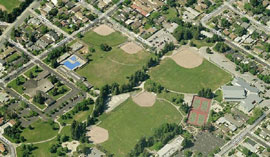 Each month, I work alongside NRPA’s PRORAGIS team to let our readers know the latest on this high-tech mapping and benchmarking database application. It’s one of the benefits NRPA offers its members, and each month there are new features available, new updates and improvements to mention, and even whole new parts of the system being rolled out. I admit, sometimes it’s hard for me to wrap my head around all that the system is and all that it can do. PRORAGIS was conceived to be the ultimate web-based melding of raw data with maps. Park operating ratio data, conjoined with topography, demography, and the built environment.
Each month, I work alongside NRPA’s PRORAGIS team to let our readers know the latest on this high-tech mapping and benchmarking database application. It’s one of the benefits NRPA offers its members, and each month there are new features available, new updates and improvements to mention, and even whole new parts of the system being rolled out. I admit, sometimes it’s hard for me to wrap my head around all that the system is and all that it can do. PRORAGIS was conceived to be the ultimate web-based melding of raw data with maps. Park operating ratio data, conjoined with topography, demography, and the built environment.
There has never before been anything like it—at least, nothing that is intended to be specific to (and supportive of) our nation’s systems of state, regional, and local parks.
Each month, after realizing that there is still more to the system that I did not know about, I enjoy the chance to hear something new from the team responsible for the design and launch of PRORAGIS. And, over the past six months, I’ve also gotten to talk with members who are using the system and enthusiastically testing it to its limits.
In the July issue, realizing that we had focused quite a bit on the ins and outs of completing agency profiles, we turned our attention to all the stuff that PRORAGIS can actually do for its users. And the list is dizzying. So much so that our Knowledge and Learning intern, graduate student Hayley Jackson, gave a big chunk of her time to compiling (and rendering into plain English) a comprehensive outline for me.
And, reading over Hayley’s list, I started to understand just how big a deal PRORAGIS is for the park managers and planners, citizen advocates, and facilities operators who belong to NRPA. For the first time, I was out of “how-to-enter-your-profile-data” articles and into the guts of a powerful (and richly visual) reporting and data-crunching machine. Do a sophisticated benchmarking comparison—in minutes—using the best nationwide data available. Make a case for a new facility in an underserved neighborhood. Explore new, untapped sources of revenue. Discover new ways of using existing facilities. Contact those who have already invested in the equipment you are considering buying. The potential for all of these uses is there—and, in this age of “wikis” and peer-to-peer collaboration models, it’s exciting to think that PRORAGIS will evolve as park departments from all over the country enter their own important pieces of the database.
“PRORAGIS: Oh the stuff you can do,” I typed at the top of the page as I prepared to send the final version to Hayley for a fact check. And it really is true. This tool will be as good as the users who invest in it—and once the data is in place, this blend of data and mapping tools could transform the way parks plan, attract visitors, bring in revenue, and serve the people in their communities.
Learn more about Park Metrics.
Maureen Hannan is the Senior Editor for Parks & Recreation magazine.

